The people who work in England's cathedrals
- Published
The cathedrals of Britain provide a place of worship for millions of Christians, a centre for study for academics of a range of subjects and a tourist attraction for visitors from the UK and abroad.
But for hundreds of people they are also a place of work.
Cathedrals operate like self-contained businesses with a large team of staff and volunteers who are responsible for everything from finance to maintenance.
But what is it like to work in some of England's oldest and grandest buildings?
The archaeologist
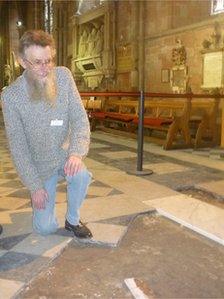
Chris Guy is the cathedral's archaeologist
Chris Guy has been the archaeologist at Worcester Cathedral for 22 years.
In that time he has supervised everything from utility work to the discovery of 180 Anglo-Saxon burials found when a floor was being replaced.
He said: "If any excavation needs to be done for access to water, electricity or gas you need permission to do it."
He began his work by trying to find out why the tower was collapsing and then he recorded the subsequent restoration.
The cathedral is an ancient monument and grade I listed with two Saxon cathedrals buried somewhere on the site.
He said: "Any work that goes on provides us with information about what happened in the past. A lot of stones were recycled and we're still looking for the Saxon cathedrals."
The master mason and works manager
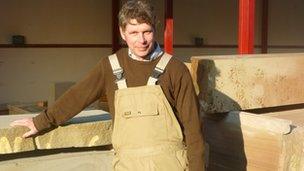
Darren Steele trains apprentice stone masons
Worcester Cathedral is one of eight in the UK to have a stone masons' workshop on site.
Darren Steele is the master mason and works manager in charge of a team of five stone masons.
They carry out restoration work and maintain the fabric of the building which is predominantly sandstone and limestone.
He said: "It's quite a privilege to keep these traditional skills going."
During the past 23 years there has been at least one, and sometimes two, apprentice stonemasons based at the cathedral.
Now the major restoration programme is complete the scheme will continue with the latest apprentice due to start this summer.
Mr Steele said: "It's quite a specialised high-craft apprenticeship.
"We will be advertising at the end of this month and are expecting quite a few applications."
He added he enjoyed training apprentices while working on a range of architectural styles.
He said: "There are 1,000 years of architectural styles as you move through the whole cathedral. I find that really interesting."
The architect
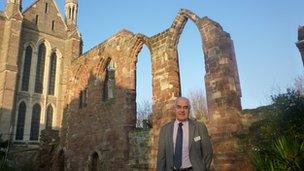
Cathedral architect Chris Romain inspects the building every five years
Chris Romain is responsible for 200 churches, three cathedrals and two abbeys across the south west of England.
Under the Care of Cathedrals Measure - the ecclesiastical equivalent of an Act of Parliament - an architect must be appointed to keep a check on the condition of these historic buildings.
An inspection is carried out every five years to determine what repairs the building needs and what order they should be completed in.
The report takes 20 working days to put together and involves Mr Romain looking over every part of the cathedral.
He said: "I inspect everywhere that can be safely accessed. It's a world of its own - what people see from the floor is completely different to what you see from a scaffolding ladder."
He added his interest in old churches may have come from his father who was a history teacher who took him around historic buildings when he was a child.
"Cathedrals are some of the top historic buildings in the country but they are also functioning places with worshippers and visitors," he said.
"It's a great place to come to work, you get included within the cathedral family."
The embroiderer

Janet Poole creates new pieces of embroidery for display in churches
At Derby Cathedral a team of volunteers maintain, conserve and make new vestments.
Janet Poole is the group's section leader for new work.
She liaises with the cathedral dean to find out what new vestments and other items of embroidery might be required and takes commissions for work from churches further afield.
She said: "We do new work mainly for the cathedral but we have new work coming in from outside as well.
"By us taking on outside work we're able to have money to support the cathedral.
"At the moment we have got a project from Beeston, in Nottinghamshire, which is very exciting.
"We did conservation of an altar cloth for them in red and then from that one of the parishioners has put up the money to have a chasuble made to go with the altar cloth."
The fabric restorer
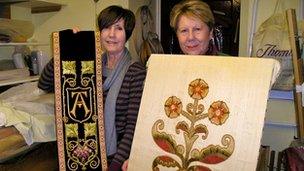
The group takes on old pieces of work which are in need of repair
Restoration section leader Barbara Walford repairs old banners and alter pieces.
The fabric behind the embroidery can often get damaged over time.
She said: "Churches contact us when they want a piece of work restored.
"We go out and have a look at them and decide if we can take on the work.
"Sadly there are some we can't take on because they are just too far gone. Churches are very damp and pieces of fabric rot."
But despite the challenges she enjoys her work.
"Some of them are utterly beautiful, they're a joy ([to work on]."
Beryl Hill also does restoration work at Derby Cathedral.
She said when she had first joined she did not have a lot of experience apart from doing embroidery at home but she has learnt on the job.
She is currently working on a Victorian altar frontal piece from St Luke's Church, in Derby, which has taken the team three years to restore.
"Hopefully it'll be in the church this year and we're quite pleased about that - it's been a long process," she said.
She added: "It was quite fun bringing it back to life just cleaning the gold work and seeing the gold peeping through when we cleaned it. It's really satisfying."
The library and archive apprentice
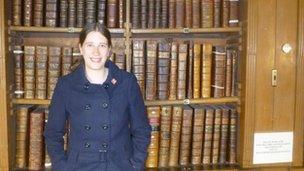
Tamsin Rowe produces exhibitions to promote the library
Tamsin Rowe is six months into a 15-month apprenticeship scheme in Worcester Cathedral's library.
The history PhD graduate's placement is being funded by the Heritage Lottery Fund.
As part of her placement she must set up four exhibitions to promote the library.
She is also learning to care for the collection, clean the books and store them and conducts tours of the library.
She said working in the library was exciting because she had the chance to find significant works.
"I was writing a blog about books on the lunar landscape and I found a book which turned out to be very rare," she said. "It was a 1647 first edition with a lunar map.
"It's always possible to discover something from any book you pick off the shelf."
The librarian archivist
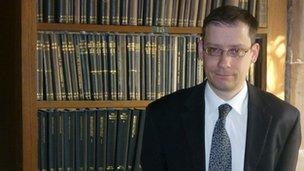
David Morrison has worked at the cathedral for 11 years
For David Morrison it was "just chance" that he ended up as Worcester Cathedral's librarian - a post he has held for 11 years.
He said: "I was doing research here and a job came up.
"It's an interesting place to work in. We have school groups, academics, inquiries from the public for family history and local history.
"There's also conservation work and we have new books as well."
Mr Morrison has to keep an eye on the 277 medieval manuscripts, 45 books from the infancy of printing between 1450 and 1500, archive documents including written records, paintings and photographs and a collection of music books.
"It's amazing how many people don't know there's a library," he said.
The choral scholar
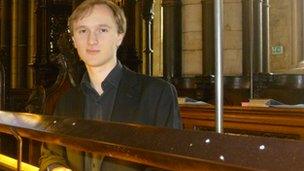
James Rhoads is a choral scholar
James Rhoads is one of two choral scholars at Worcester Cathedral.
Originally from Australia, he now sings during regular religious services as well as weddings and funerals.
He said: "It's a tradition stretching back for years, you are just the next step in that tradition.
"The volume of music you have to learn makes it a trial by fire.
"There are things you learn which benefit you in a number of careers, not just those involving music. You learn to manage your time."
The acting assistant organist
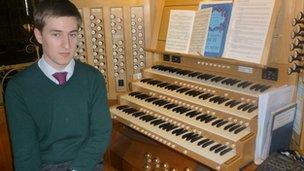
George Castle plays the organ during services
George Castle began his work at Worcester as an organ scholar.
He is now one of three full-time organists who play music during services and accompany the choir when they practice.
He also helps the cathedral conduct outreach work with young singers.
He said: "As a musician you tend to either become a freelance professional musician with an orchestra or you get a recording deal.
"With the organ you have a ready made career.
"I played the piano from the age of seven and I was always quite interested in playing the organ. I started playing when I was 11 as soon as I was tall enough to reach the pedals.
"It's a wonderful instrument to play, the best noise on it is the building itself."
- Published25 March 2012